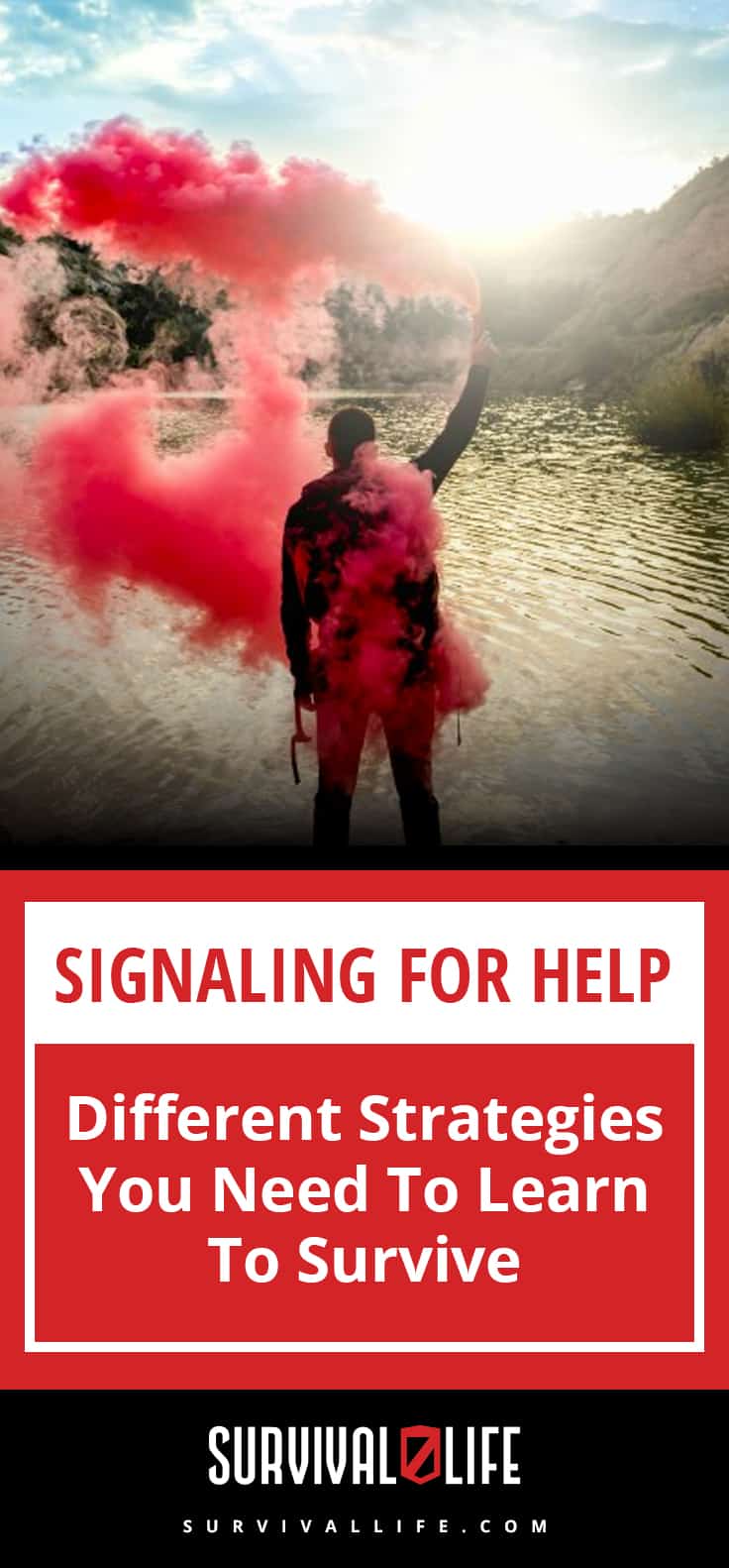Emergency Communications
Signaling for Help | Different Strategies You Need To Learn To Survive

You hear a great deal of big talk about survivalists hunting animals with spears, building elaborate shelters, and rubbing two sticks together. However, real survival is typically about finding rescue by learning the different ways in signaling for help.
Signaling For Help | Learning The Different Strategies
There are times you might be stranded a mile from help, and times you might be 50 miles from the nearest person. However, with a proper signaling strategy you can find help in almost every scenario.
Contrast
No matter how you plan to signal for help, contrast is the key. This is the principle of ensuring that your signal stands out from its surroundings. For a stationary signal, this could mean bright colors against a drab background. It could mean letters or shapes in a natural environment. For a smoke signal, it could mean black smoke against a white sky or white smoke against a blue sky. As for sound based signals it could mean a horn, a whistle, or the sound of metal clanging. Contrast light signals, it means a bright light against a dark background, a flashing light, or a light making a pattern. All of these are examples of creating contrast using your signal.
Light Signals

Using light to signal for help is one of the best ways to get the attention rescue personnel. LED flashlights and laser pointers are great for signaling at night. You can simply flash them on and off, or you can use Morse code to signal ‘SOS’. One of the most common ways of signaling is using a reflective surface like a mirror. This allows you to bounce the light of the sun off of a distant target. You can poke a hole in the center to help you aim these flashes of light at a helicopter or car. Just remember that you must be facing the sun to signal a target that you are facing. All of these visual signals can work miles away from their targets.
Sound Signals
Sound is another excellent way to signal for help, especially if the sun is not visible. You can yell for help, but you will tire quickly and often your voice will be drowned out by the wind. A whistle is a very common signaling tool to use as it requires less effort and reaches much further than a human voice. If you can find anything made of metal, you can often bang on it to create a distinct sound that carries. Just remember that sound rarely travels as far as light. In addition, windy conditions and valleys make sound signals more difficult.
Smoke Signals
By simply building a fire, you can often signal for help. You will need a good way to start that fire, so a lighter or Ferro rod is good to have. Once the fire is started, you will need a way to create contrast. You can use rubber or plastic for black smoke, or green vegetation for white smoke. To create a pattern, you can build three signal fires about 50 feet apart. You can also use a blanket or tarp to waft the smoke and create a signal with the plumes. Typically Morse code is used for this as well. Just wait to add the plastic or green vegetation until you think you have rescue personnel in range. You do not want to run out of supplies too early.
Stationary Signals, Flagging, and Vehicles
Stationary signals are large letters or shapes made in contrast with the ground. These must be visible from the air. Three equal lines is a universal sign of distress. If you have any material that is bright in color, you can attach it to a long pole and move to a high spot. Wave it back and forth when rescue teams are in range. Finally, remember that a vehicle is often your best signal. It is large, colorful, and metallic. You have a horn and headlights for sound and light. You can even burn parts of the car for black smoke, or bang on the hood for a sound signal.
Bear Grylls survival tip of the week is posted by Discovery Channel Southeast Asia:

-

 Do It Yourself7 months ago
Do It Yourself7 months agoParacord Projects | 36 Cool Paracord Ideas For Your Paracord Survival Projects
-

 Do It Yourself9 months ago
Do It Yourself9 months agoHow To Make Paracord Survival Bracelets | DIY Survival Prepping
-

 Do It Yourself9 months ago
Do It Yourself9 months ago21 Home Remedies For Toothache Pain Relief
-

 Do It Yourself10 months ago
Do It Yourself10 months agoSurvival DIY: How To Melt Aluminum Cans For Casting
-

 Exports8 months ago
Exports8 months agoAre Switchblades Legal? Knife Laws By State


Jumpoff A
December 19, 2017 at 2:50 PM
Signaling For Help | Learning The Different Strategies has a few basic ideas; but, it really doesn’t cover the full story. When signaling for help the first thing you need to do is not to give up hope. You must be persistent, patient and prepared for disappointment. The major problem in signaling for help is APATHY and IGNORANCE.
We all have heard the story of people needing help only to be ignored by so many people on their day to day routines. They may see you in need of help but for one reason or another they will pass you by, all the while offering their feeble excuses. To those offering their excuses; their reasoning is justified. However, for the one in need of help; the excuses fall short of being valid. How many times have you heard an alarm go off or a siren screaming for you to get out of the way and you either ignore or take your sweet time moving? In this day and age we have grown accustomed to having someone else come to the rescue because they “trained” to do so.
Apathy is a fear of getting involved because people are taken out of their comfort zone and must take a chance on the unknown. Often times they come away feeling bad about themselves or the situation they were put in by coming involved in something that is none of their business, or so they think. Often when confronted with a dire emergency, people fail to think properly, and do the proper thing. How many people know CPR, the Heimlich maneuver, or when to apply pressure to a sever cut? How about when they see a flare, smoke signals, or hear a whistle?
Ignorance occurs when we fail to recognize when someone is asking for help or is need of help. It can come in many forms from a desperate look or odd behavior to blatantly obvious. Case in point, a small child looking up, to you, for help to a homeless person in the need of food and shelter.
We must be aware of the different signals used to request help. We must use good judgement and concern when investigating the requests for help. There must be a uniform way of asking such as using 911 on the telephone so that there is no mistake that someone is requesting help. For example, three long blasts on a whistle followed by three short blasts, this is SOS by-the-way. The waving of a orange cloth for help. Orange is an unusual colour and if someone is waving it it means that need help. Even smoke signals can be used if done properly and everyone knows it means you need help. We as a society must understand and must be prepared to act when we see these tell-tailed signs. More importantly, everyone must be vigilant and be on the lookout for these signs and requests for help. Prepared to render aid no matter what, even if it is to pass the concern on to someone that is more able than yourself.
If you find yourself in the need of assistance or help be persistent and patient. Don’t give up hope just realize that not everyone knows that you are in need of help. It might be one in ten people who will know that you need help or perhaps one in a hundred. You must do what you need to do to survive while maintaining your strategy to continue to signal for help. Sometimes, you have to think outside the box to create contrast to signal for help. Think about those that you know that may be looking for you. What will get their attention. Then think about those that are not looking for you and how you can get their attention and apply a signal that will get their attention. For example, Hansel and Gretel used bread crumbs to find their way back, what if you used colour string/ tape, even if it is to direct someone to your position or pre-written message on the ground where you may be found. By thinking outside the box, staying calm, you must be persistent, patient and prepared for disappointment only to start all over again.
Pingback: Beer Can Hacks | Surprising Survival Uses for Beer